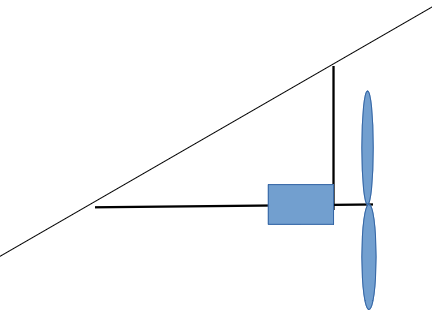What is the most simple airborne wind energy architecture?
I, of course, propose the Daisy network kite
What is the most simple airborne wind energy architecture?
I, of course, propose the Daisy network kite
Turbine lifted by kite

nah, Too many steps, mechanical to electric in the air and then transfer to ground…is too hard to sustain weight and dependant on massive lift - no scalability. Also needs torque compensation aloft. Risks line strike and tangle.
I believe a simple Yoyo with a rigid kite is among the simpler.
We should define simple in this discussion. And also secondary concerns as you say, eg. scalability
Yoyo solar balloon… or that’s not wind energy… then a kite being dragged downwind attached to a generator.
@tallakt you’re right we need to define simple.
Not needing a controller, or any software would be a start. No yo-yo would survive that metric.
As for the kite going downwind… Ha ha ha ha
That’s a yo-yo with the age old question… How long is a piece of string?
Not a yo-yo, but only a yo. 
If the task is to do work then have a kite drag or lift a weight. That’s pretty darn simple.^^ Useful? No. But simple.
Plough kite is great when you have a crosswind field
So simple in this matter would imply using passive, unpowered kites. That leaves just a few options I guess. We have the daisy which is quite good.
I would say an oscillating kite with energy absorbtion on the ground is the simplest you could get. For instance an oscillating kite mounted on a flywheel rotating at the oscillation frequency of the kite.
Even simpler than daisy, as the simplest solution will probably only have one kite.
Im not sure if simple is easily defined. Until you have actually built something to generate useful power, you dont know how complex the remaining details will be. Eg: The Daisy is quite simple, but to handle different wind directions and higher wind may prove complex. Or going to a useful altitude and still not be bogged down by tether drag. (just some thought up issues, probably not very relevant). Using electric control is in itself not a simple solution, but once that part is accomplished, the rest may be simpler to achieve (eg depower in high wind, automatic handling etc)
Ok
Here is super simple
Skybow arch
If you don’t bother with a backstop line… Daisy changes with the wind no problem.
I think the practicable Daisy torque tube scaling length is a lot longer than most AWES folks imagine. I have no idea what it is. Small rinfs with short gaps have proven an extremely lightweight long shaft can handle power well. However we don’t need that length as you can just start adding kite rings instead.
Rod, what kind of propeller you had during that test up there? What rope did you use? 2 lines?
What’s makes it not feasible according to you?
A kite
@Kitewinder It was a Roy Mueller skybow arch… A rotary arch ribbon kite. http://rexresearch.com/skybow/mueller.htm
Here’s another test I did where we flew the skybow in mid air between 2 x lifter kite lines
Another test video
Guangdong High-Altitude Wind Power Technology tested a low technology wing as a parachute, using yoyo method, that makes sense in my opinion. The ground installations seem yet complex. Some photos on:
https://www.google.com/search?safe=off&rlz=1C1CHNV_enUS423US423&tbm=isch&sa=1&q=site:.gdgkfn.com&oq=site:.gdgkfn.com&gs_l=img.12...7533.11299.0.14758.6.6.0.0.0.0.122.499.4j2.6.0...0.0.0..1c.1.17.img.CtFeEKukQ0w&bav=on.2,or.r_cp.r_qf.&biw=1454&bih=713&imgdii=_&cad=h#imgrc=gjhW-5PlgAzGKM:&spf=1548944167901.
Some details are on the attachment below.
chinese umbrella description.pdf (1.3 MB)
Basically what I want to do with lifters with pitch control instead of parachutes.
Their description and the groundstation design is overly complicated. Seems like they like to display things as complicated, can’t think of any other reason why they would include a drawing of planetary gears.
The parachute can be simple. But the groundstation is overly complicated as you mention.
Basically a playsail is a rectangle connected by a tether in each corner. So it can be a current tarp with eyelets.
In the the first video the two lower corners are close, perhaps in order to improve some aerodynamic features and the elevation angle. Yoyo method can be used.
It is difficult to make a less expensive and complex airborne wind energy system. Can be it efficient and safe enough?
I have some ideas to improve the performance of the umbrella kite energy device. With this system the umbrellas are subject to cosine cubed losses. These losses are always more than the gain in performance due to higher winds at altitude. The best performance will be obtained at minimum tether angle. Instead of using a lifter kite or helium balloon to support the train of parachutes, we should use a lightweight structure which is supported by guide wires. The load on this tower is minimal since most of the force is the pulling of the parachutes on the unwind reel.
For example, if the unwind reel is located 4 meters above the ground and the top of the tower is 30 meters high, then most of the area below the system can be used for farming or recreation.
The natural sag of the tether might be advantageous because downwind parachutes will be less affected by the wake of those upstream. We may be able to space the parachutes closer together.
A big advantage of this system is that problems of launch and land will be eliminated because the parachutes can be retracted and stored on the tether. For low wind conditions the parachutes can stay in place draped over the tether.
For changes in wind direction, rather than relocating the tower, the winder station can be moved in a circle around the tower.
Which produces more power, parachutes or autorotating turbines sweeping the same area? Which is heavier? Q
The simplest airborne wind energy system is one you never build, and just talk about on the internet. They are problem-free, maintenance-free, and always perform exactly the way the promoters wish.